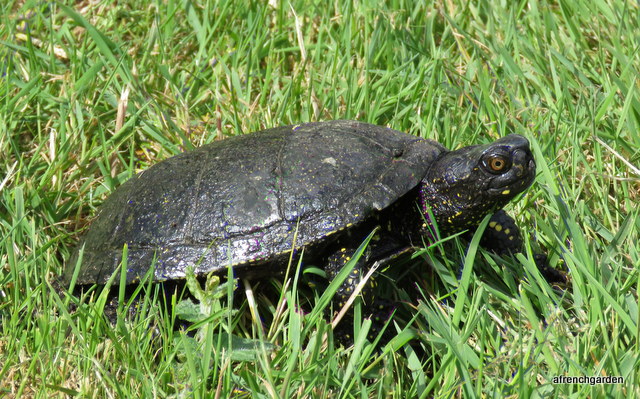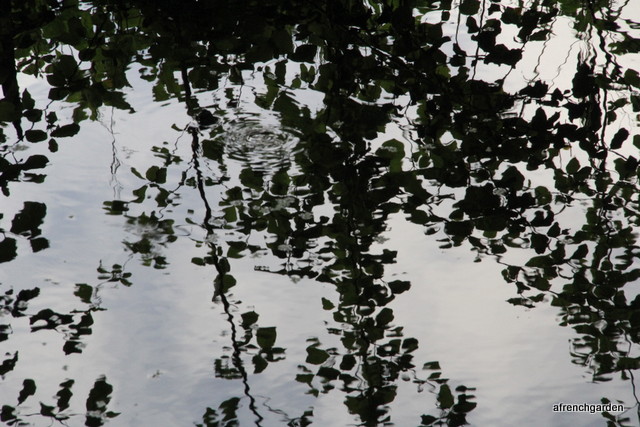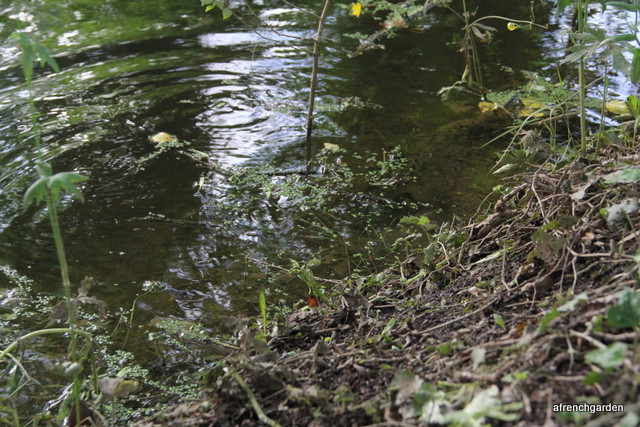This afternoon my husband found a tortoise in the garden.
I had never seen a tortoise like this before. I could only guess that it was an exotic species someone had bought as a pet. I had only heard of people keeping the Mediterranean type of tortoise that will breed in captivity here and it certainly was not one of those. For a start it was much more vigorous and active than your average tortoise.
In addition, we could think of no-one nearby who would keep and exotic tortoise. I felt that if I could identify it that it might be useful, as I was concerned that someone might be missing their pet. Perhaps I could put an advertisement in the local pet shop?
I started searching on Google but I did not get very far so I decided to email my granddaughter, Daisy as she is into reptiles, amongst most other animals. She replied immediately that it was a European pond turtle. Disappointed, I replied that it could not be a turtle as it had feet with claws just like a tortoise.
However, I did do an internet search and, of course, I had to send her my apologies. Emys orbicularis is the European pond turtle, cistude, tortue boueuse or tortue des marais in French. European pond turtles do have clawed feet! However, I have yet to meet anyone around here who has seen one or heard of them. I was unaware of their existence.
Actually, it is not so surprising as they are very rare in the area and like most wildlife, getting rarer. They live in marshy areas, ponds or slow moving water channels. There are populations in the Charente Maritime but I can imagine that they would be very difficult to see on the banks of a river or in in wetlands. The heavy rain we have experienced of late had perhaps swept it from the known colonies although the Seudre, which runs at the bottom of the garden, is known to possess them. The poor beast was only enjoying a sunbath in the back garden border when it was pounced on.
Once we had realised what it was and that far from being a lost pet, that it is a protected species, we decided to put it back in the river.
He (from the length of his tail and his concave underside, I deduced it was a male) did not seem in a rush to get into the water and we had to point him in the right direction as we did not want him to find his way onto the road.
But as soon as he saw the river he took to it like a turtle to water!
He was soon gone!
His head did break the surface again to look back, then disappeared under again leaving only the ripples.
I wonder if he liked the garden? Will he come back? Will I spend a long time staring into the river instead of getting on with the gardening?
The big release was filmed on this short video https://youtu.be/amn605L84Pg (15 secs)








I really enjoyed your post Amelia, you last line made me laugh out loud, I’d be looking into the river where I just know you will be too. Where is the river in relation to your garden?
LikeLike
It is just at the end of the garden, so it just had to walk in. I had just never realised that there were wild turtles in Europe, or France in particular. I must admit I have become very bee orientated. Amelia
LikeLike
Neat . . . and there goes your chance at having a pet turtle.
LikeLike
He was very cute but very feisty and much more suited to a life in the wild. I do not think he would have been very happy as a pet. The Mediterranean tortoises are much slower and make more suitable pets – if captive bred. Amelia
LikeLike
I have never seen one of these either. Clever granddaughter being able to identify it. I did think it was a very strange tortoise with such a long tail. Maybe it will come back and visit.
LikeLike
They could very well go unnoticed so maybe there is a population of them around here. Amelia
LikeLike
What a lovely visitor to have in the garden! Turtles and Tortoises are becoming rarer the world-over so it’s great to have one living so close by 🙂
LikeLike
We have had a lot of rain these past two years so it could possibly have increased their range. However, spotting a black turtle in dark water or a shady bank seems just about impossible to me so they might have always been in the area. My husband only found it as it was walking in the garden, probably looking for a mate at this time of year. Amelia
LikeLiked by 1 person
It’s wonderful to have unexpected visitors to the garden!
LikeLike
Gardening is not just growing flowers, it leads to finding out about so much. 🙂 Amelia
LikeLike
Yes, a gateway drug, it is.
LikeLiked by 1 person
You won’t believe this! By coincidence we also found one in the middle of the road, thinking it might be an escaped pet. We picked it up and sought advice from Tim and Pauline Ford. Turns out it was unknown in that particular area and a very interesting find. An expert came out from Tours, fitted it with a tracker and released it again in the same area.
We were amazed at how quickly ‘Terry’ could move.
Of course, as it is protected we shouldn’t have picked it up. However, doing so has led to the knowledge that it has spread to previously unknown areas. Tim, Pauline and the expert were very excited. Turns out he was male and six years old.
LikeLike
Wow! How exciting! It will be so good if you get news of Terry. We noticed how lively ours was compared to a tortoise. It makes me feel better that you made the same mistake as us. Actually, even though it is a protected species you did the correct thing in removing it out of danger. Let’s hope if we speak about our experiences more people will become aware of the European turtles and you never know it could lead to others being saved from being run over or mistakenly kept as pets :). Amelia
LikeLike
Excellent. Well done on saving your stray. I’m very fond of tortoises (more so than turtles). It comes from having three as a kid. Hector, Horace and Hermes were a delight to have in the garden. But seeing wild tortoises in Greece a few years back was a real thrill. Dave
LikeLike
I have a very soft spot for tortoises. Having three in a garden must have been great. When we lived in Greece the tortoises used to come into the garden there, although I suspect they were sneaked in by the children who used to find them. Amelia
LikeLiked by 1 person
The concave underside is a male trait… to “fit” the female…
and now… early May is when the males go “walkabout”….
and the recent rains have helped as ditches are much wetter than normal.
How do I know this….?
We had the privilege to be entertained by one here a couple of days ago.
Some friends found it in the middle of the road…
and thinking, like you, it could be someone’s pet, they “rescued” it…
the next day, as we are recorders for Faune Touraine, they brought it here.
A bit of frantic telephoning on Pauline’s part resulted in a VERY excited young scientist coming to collect it…
it will be released as close as possible to where it was found…
but wearing a tracking device.
We hope to be able to follow its fortunes!??
Our friends had found it five kilometres further North than any previous records….
this could mean that the population from the north-west of the Brenne is expanding outwards…
and this one…. a six, rising seven year old male… was younger than the previous.
In a very short period of time we have learnt a great deal about cistudes!!
For the sake of the species, you really need to report your sighting to the nearest recorder…
or preferably….start recording all your various sightings on
Faune Charente-Maritime
http://www.faune-charente-maritime.org/
this “citizen science” is exceptionally important…
and if you have a picture that allows the rings on one of the large scales to be counted, its age can be estimated.
They live up to sixty years in the wild… and over a hundred has been reported from captive specimens.
So, please, register with Faune Charente-Maritime and become recorders of the wildlife in your area… you have around sixteen different groups to record… including one especially for you… hymenoptera… but not just your bees… all of the group!!
We’ve only got a “boring” five to record into!!
But that does include dragons and damsels… my favourites.
LikeLiked by 1 person
I have now registered. I did not find it easy so your ears might have been burning. However, I do agree with you on the importance of citizen science and I do very much admire the scientists who are working in the area of natural sciences and ecology at this difficult time. I feel the spread of knowledge and understanding may start to alleviate some of the problems flora and fauna are subject to at this time. Amelia
LikeLike
Thanks Amelia…
I didn’t find it easy, either…
I have to keep the “password” they gave me as a cut and paste…
it just isn’t memorable. Pauline’s is much easier…
sorry!!
But as you say, it is worth it!
But as Gaynor says, above, if they hadn’t picked it up, a possibly unknown…
or expanding population wouldn’t be known about….
or on that bit of road… would just become part of the tarmac!!
There is protection and protection…
some of the qualified guides around here will quite frequently pick a wonderful flower and wave it under our noses….
and point out that it is “very rare and protected in France!!”
Hmmmmmmmmmm??
I shall be blogging about Terry Pin very soon…
LikeLiked by 1 person
I stay permanently logged on to Faune Touraine though it’s one password I can remember! For some reason I found “Transmettre vos observations” reasonably easy to use but then I’ve seen a lot of rubbish data entry screens… There is an android app which I haven’t seen but it may be easier to use – still waiting for an IOS version. I think this had better be a blog post – a guide to natural history recording with Visionature for anglophones. Pauline
LikeLike
I suppose it cannot be helped, but I find setting up an identity on sites very trying. 😦 Amelia
LikeLike
Hello Amelia,
A fascinating find and comments. How exciting! As you say, you’ll be on turtle watch from now on every May. That will definitely beat weeding/gardening…
BW
Julian
LikeLike
The garden always ends up surprising you. Although I did not enjoy struggling with a web site to report the find as Tim suggested, in fact that was worse than weeding. Amelia
LikeLike
What an exciting find and so unexpected!
LikeLike
I did think it was a bit remiss of me not to have known that European turtles existed in the wild. I have talked to neighbours and they did not know (care?) either. Is it that I have not noticed mention of them in the nature/tourism type leaflets around here or do they not get enough press? Is it that people care about Pandas but not turtles or snakes? Amelia
LikeLike
Each summer I find turtles out in the woods, quite far from any water source. I never know how they got there or what they are doing. It seems like an awful long way to go to lay their eggs.
LikeLike
In “English” English we call water dwelling turtles – turtles but the ones that live on the land tortoises (like the ones you get in Greece or the Galapagos Islands). In the States you call them all turtles. Are your turtles water dwelling ones? Perhaps, they just like damp areas and not the arid places that some tortoises live in. I think I need to find out a lot more about turtles/terrapins and tortoises and the difference between them all. Amelia
LikeLike
Yes, the turtles I find in the woods are the common snapping and painted turtles. Neither is a “wood turtle.” From what I’ve read we don’t have tortoises in New England but we have many different turtles.
LikeLiked by 1 person
He’s splendid, but I’m glad I didn’t meet him in my garden. I have memories of finding snapping turtles while weeding with my granny in her Canadian garden. We were always told horrific stories about them when I was little – they can take your arm off, etc. Untrue, I’m sure, but your visitor would have had me on the run!
LikeLike
This one was not aggressive at all. I think the common name of your native turtle sort of gives the game away as to its lack of friendliness :). Amelia
LikeLike
The turtles are all carnivores… in the main…
even with an Emys it pays NOT to wiggle fingers within reach!!
They have strong bites and sharp edges to the jaws…
’nuff said!
LikeLike
What an interesting visitor
LikeLike
He certainly was and I learnt a lot from him. Amelia
LikeLike
How exciting Amelia! I’d be over the moon if I found a fellow like that in my garden!
LikeLike
The visit was quite a sharp learning curve and I want to discover more about them. Are there more around than we think or was he so lonely he was forced to search my garden in the hope of finding an elusive mate? Amelia
LikeLike
That’s got to be the strangest wild visitor I’ve seen… Sue
LikeLike
I just felt sorry to see him swim off. I don’t suppose I’ll ever see him again. It is not like the birds and the bees that always visit the garden. Amelia
LikeLike
Terrific find, Amelia. I rather hopes he makes a return visit to your garden. Daisy sounds a very handy granddaughter in these circs. We rely on ours (9) for butterflies! RH
LikeLike
It is good when the grandchildren come in handy. Amelia
LikeLiked by 1 person
I agree, what a wonderful find! I’m sorry to have had a break from spring blogging activities and looking forward to catching up in your garden now – particularly as I’ll need tips for ours. I’ll now know what to do if we get a curious tortoise-looking creature wander into our garden and head towards the fish pond. Thank you for sharing such a fun story 🙂
LikeLike
I think you get the escaped Florida turtles in the south of England so maybe it really could happen! Amelia
LikeLiked by 1 person
I’ll look out for escapees in the garden!
LikeLike
Pingback: A pond for the garden | a french garden